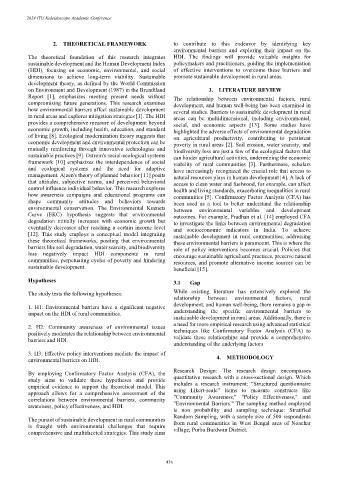Page 480 - Kaleidoscope Academic Conference Proceedings 2024
P. 480
2024 ITU Kaleidoscope Academic Conference
2. THEORETICAL FRAMEWORK to contribute to this endeavor by identifying key
environmental barriers and exploring their impact on the
The theoretical foundation of this research integrates HDI. The findings will provide valuable insights for
sustainable development and the Human Development Index policymakers and practitioners, guiding the implementation
(HDI), focusing on economic, environmental, and social of effective interventions to overcome these barriers and
dimensions to achieve long-term viability. Sustainable promote sustainable development in rural areas.
development theory, as defined by the World Commission
on Environment and Development (1987) in the Brundtland 3. LITERATURE REVIEW
Report [1], emphasizes meeting present needs without
The relationship between environmental factors, rural
compromising future generations. This research examines development, and human well-being has been examined in
how environmental barriers affect sustainable development
several studies. Barriers to sustainable development in rural
in rural areas and explores mitigation strategies [1]. The HDI areas can be multidimensional, including environmental,
provides a comprehensive measure of development beyond
social, and economic aspects [13]. Some studies have
economic growth, including health, education, and standard
highlighted the adverse effects of environmental degradation
of living [8]. Ecological modernization theory suggests that
on agricultural productivity, contributing to persistent
economic development and environmental protection can be poverty in rural areas [2]. Soil erosion, water scarcity, and
mutually reinforcing through innovative technologies and
biodiversity loss are just a few of the ecological factors that
sustainable practices [9]. Ostrom's social-ecological systems can hinder agricultural activities, undermining the economic
framework [10] emphasizes the interdependence of social
viability of rural communities [3]. Furthermore, scholars
and ecological systems and the need for adaptive
have increasingly recognized the crucial role that access to
management. Ajzen's theory of planned behavior [11] posits
natural resources plays in human development [4]. A lack of
that attitudes, subjective norms, and perceived behavioral access to clean water and fuelwood, for example, can affect
control influence individual behavior. This research explores
health and living standards, exacerbating inequalities in rural
how awareness campaigns and educational programs can communities [5]. Confirmatory Factor Analysis (CFA) has
shape community attitudes and behaviors towards
been used as a tool to better understand the relationship
environmental conservation. The Environmental Kuznets between environmental variables and development
Curve (EKC) hypothesis suggests that environmental
outcomes. For example, Pradhan et al. [14] employed CFA
degradation initially increases with economic growth but to investigate the links between environmental degradation
eventually decreases after reaching a certain income level
and socioeconomic indicators in India. To achieve
[12]. This study employs a conceptual model integrating sustainable development in rural communities, addressing
these theoretical frameworks, positing that environmental
these environmental barriers is paramount. This is where the
barriers like soil degradation, water scarcity, and biodiversity role of policy interventions becomes crucial. Policies that
loss negatively impact HDI components in rural
encourage sustainable agricultural practices, preserve natural
communities, perpetuating cycles of poverty and hindering resources, and promote alternative income sources can be
sustainable development.
beneficial [15].
Hypotheses
3.1 Gap
The study tests the following hypotheses: While existing literature has extensively explored the
relationship between environmental factors, rural
development, and human well-being, there remains a gap in
1. H1: Environmental barriers have a significant negative
impact on the HDI of rural communities. understanding the specific environmental barriers to
sustainable development in rural areas. Additionally, there is
a need for more empirical research using advanced statistical
2. H2: Community awareness of environmental issues
positively moderates the relationship between environmental techniques like Confirmatory Factor Analysis (CFA) to
validate these relationships and provide a comprehensive
barriers and HDI.
understanding of the underlying factors
3. H3: Effective policy interventions mediate the impact of
4. METHODOLOGY
environmental barriers on HDI.
Research Design: The research design encompasses
By employing Confirmatory Factor Analysis (CFA), the
quantitative research with a cross-sectional design. Which
study aims to validate these hypotheses and provide
empirical evidence to support the theoretical model. This includes a research instrument: “Structured questionnaire
using Likert-scale” items to measure constructs like
approach allows for a comprehensive assessment of the
correlations between environmental barriers, community "Community Awareness," "Policy Effectiveness," and
"Environmental Barriers." The sampling method employed
awareness, policy effectiveness, and HDI.
is non probability and sampling technique: Stratified
Random Sampling, with a sample size of 500 respondents
The pursuit of sustainable development in rural communities
from rural communities in West Bengal area of Noachar
is fraught with environmental challenges that require
comprehensive and multifaceted strategies. This study aims village, Purba Burdwan District.
– 436 –

